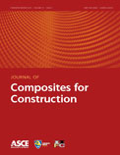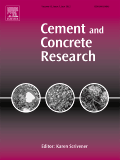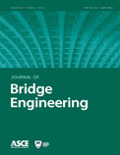
JOURNAL OF COMPOSITES FOR CONSTRUCTION
Scope & Guideline
Bridging Theory and Practice in Composite Construction
Introduction
Aims and Scopes
- Composite Materials in Structural Applications:
The journal primarily emphasizes the use of fiber-reinforced polymer (FRP) composites, including glass (GFRP), carbon (CFRP), and basalt (BFRP), for various structural applications. Research often involves exploring the mechanical performance and effectiveness of these materials in reinforcing concrete structures. - Durability and Environmental Resistance:
A significant focus is on the durability assessment of composite materials under various environmental conditions, such as seawater exposure, freeze-thaw cycles, and elevated temperatures. This includes studies on the long-term performance and degradation mechanisms of FRP materials. - Seismic and Structural Behavior:
The journal extensively covers seismic performance and retrofitting techniques using composite materials, highlighting innovative design approaches to enhance the resilience of structures against seismic events. - Modeling and Analytical Techniques:
Research often employs advanced modeling techniques, including finite element analysis and machine learning approaches, to predict the behavior of composite materials in structural applications. This includes bond behavior, load-carrying capacity, and damage assessment. - Innovative Construction Techniques:
The journal encourages research on novel construction techniques that incorporate composite materials, such as precast elements, hybrid systems, and innovative anchoring methods, to improve construction efficiency and structural integrity.
Trending and Emerging
- Sustainability and Eco-Friendly Materials:
Recent publications show a growing interest in sustainable construction practices, including the use of eco-friendly materials and methods. Research on the performance of composites made from recycled materials or those that reduce environmental impact is on the rise. - Advanced Computational Techniques:
There is an increasing trend towards the application of advanced computational techniques, such as artificial intelligence and machine learning, for predicting the performance of composite materials. This shift indicates a move towards more sophisticated analysis tools in structural engineering. - Hybrid Composite Systems:
Research focusing on hybrid systems that combine different types of reinforcements, such as FRP and traditional materials, is gaining traction. This trend reflects a desire for enhanced performance characteristics in structural applications. - Durability in Harsh Environments:
The journal is seeing more studies dedicated to the durability of composite materials in extreme environments, such as marine or corrosive settings. This trend is essential for ensuring the longevity and reliability of structures in challenging conditions. - Innovative Retrofitting Solutions:
Emerging themes include innovative retrofitting techniques using composites to enhance the seismic performance of existing structures. This reflects an increasing need to upgrade aging infrastructure with advanced materials.
Declining or Waning
- Traditional Reinforcement Techniques:
There is a noticeable decrease in the publication of studies focused solely on traditional reinforcement techniques without the integration of composite materials. This suggests a shift towards more innovative and hybrid methods involving composite reinforcements. - Basic Mechanical Testing:
Research centered on basic mechanical testing of composite materials without advanced analytical or computational approaches has been waning. The trend indicates a preference for studies that incorporate complex modeling and predictive analytics. - Generalized Design Guidelines:
The publication of generalized design guidelines for FRP applications has diminished, as recent research tends to focus on specific case studies or innovative applications rather than broad, prescriptive guidelines. - Non-Structural Applications:
There is a decline in research addressing non-structural applications of composite materials, as the journal increasingly prioritizes structural performance and engineering applications.
Similar Journals

Advances in Concrete Construction
Advancing Knowledge for a Stronger TomorrowAdvances in Concrete Construction, published by TECHNO-PRESS in South Korea, is a pivotal academic journal dedicated to the fields of Building and Construction, Civil and Structural Engineering, and Mechanics of Materials. Established with the aim of fostering innovative research, this journal has rapidly gained recognition, achieving a commendable Q2 ranking across multiple categories, including Safety, Risk, Reliability, and Quality as of 2023. Featuring a blend of rigorous peer-reviewed articles, the journal serves as a vital platform for scholars, engineers, and students alike to disseminate cutting-edge research and practical applications in concrete construction technologies. Despite its absence of Open Access, the journal's inclusion in Scopus with notable rankings - such as #66 in Building and Construction - underscores its growing influence and commitment to quality as it converges on significant advancements from 2016 to 2024. By contributing to this respected journal, you join a community dedicated to exploring the future of sustainable and efficient construction practices.

JOURNAL OF COMPOSITE MATERIALS
Driving Excellence in Composite Materials ResearchJOURNAL OF COMPOSITE MATERIALS, published by SAGE PUBLICATIONS LTD, is a premier academic journal dedicated to advancing the field of composite materials. With a long-standing history since 1967, this journal serves as a vital platform for researchers and professionals in the areas of ceramics and composites, materials chemistry, mechanical engineering, and mechanics of materials. The journal's impact is further underscored by its Q2 quartile ranking in various categories as of 2023, alongside notable Scopus rankings in multiple engineering and material science disciplines. Though it currently lacks Open Access options, its rigorous peer-review process ensures the high quality and relevance of its published research. This journal is instrumental in fostering innovation and promoting collaboration among academics and industry professionals, making it essential reading for anyone involved in materials science and engineering.

CEMENT AND CONCRETE RESEARCH
Connecting Research with Real-World ApplicationsCement and Concrete Research is a prestigious peer-reviewed journal published by Pergamon-Elsevier Science Ltd, dedicated to advancing the field of building and construction materials. With an impressive impact factor securing its place in the Q1 quartile rankings for both Building and Construction and Materials Science, this journal serves as a vital platform for disseminating high-quality research. Since its inception in 1971, the journal has evolved to include a broad scope that encompasses innovative studies on cement, concrete, and their applications, fostering knowledge that directly impacts industry practices. Although it is not an open-access journal, it is widely recognized for its significant contributions, ranking #2 out of 223 in Engineering: Building and Construction and #17 out of 463 in General Materials Science. Researchers, professionals, and students alike are encouraged to engage with the latest findings published in this journal, which remains at the forefront of scientific inquiry in materials innovation and development.

Masonry Society Journal
Exploring the depths of masonry science and technology.Masonry Society Journal, published by the Masonry Society, is a pivotal resource in the field of masonry and construction materials. With a dedicated ISSN of 0741-1294, this journal aims to disseminate cutting-edge research, innovative practices, and technical insights that contribute to the advancement of masonry science and application. Although not openly accessible, the journal serves as a vital platform for academics, professionals, and students alike, providing valuable knowledge that enhances the quality and safety of masonry structures worldwide. Located in Boulder, Colorado, the Masonry Society Journal is committed to fostering community engagement in research and education, making it a crucial reference for those seeking to deepen their understanding of masonry technologies and their implications in contemporary building practices.

Journal of Structural Integrity and Maintenance
Championing Knowledge for Safer, More Efficient StructuresThe Journal of Structural Integrity and Maintenance, published by Taylor & Francis Ltd, serves as a prestigious platform dedicated to the advancement of knowledge in the fields of structural integrity, civil engineering, and materials science. With an ISSN of 2470-5314 and an E-ISSN of 2470-5322, this journal is uniquely positioned to address the critical challenges faced by researchers and professionals in building and construction, mechanical engineering, and related domains. Since its inception in 2016, this journal has been consistently recognized for its quality, currently holding a Q2 rank across several disciplines, including Building and Construction and Civil and Structural Engineering in 2023. The journal aims to publish high-quality research that contributes to the understanding and maintenance of structural integrity, fostering innovations that promote safety, efficiency, and sustainability in engineering practices. Researchers and students alike are encouraged to engage with this rich repository of knowledge, which plays a vital role in shaping future advancements in structural engineering and materials science.

Journal of Bridge Engineering
Advancing the Future of Bridge EngineeringThe Journal of Bridge Engineering, published by the ASCE - American Society of Civil Engineers, is a premier academic journal dedicated to the specialized field of bridge engineering and structural design. With a strong commitment to advancing knowledge from 1996 to 2024, this journal is recognized for its excellence, holding a prestigious Q1 ranking in both the Building and Construction and Civil and Structural Engineering categories according to the latest 2023 metrics. The journal's ISSN 1084-0702 and E-ISSN 1943-5592 signify its commitment to scholarly communication in a digital age. While it does not currently follow an open access model, the Journal of Bridge Engineering significantly impacts the engineering community, appealing to researchers, professionals, and students who seek cutting-edge research and innovative practices in bridge engineering. Its current rankings on Scopus place it among the top journals in its field, reinforcing its role as a critical resource for advancing the state of the art in bridge design, maintenance, and sustainability.

Composites Theory and Practice
Bridging Theory and Practice in Advanced Material ScienceComposites Theory and Practice is an esteemed academic journal published by the Polish Society of Composite Materials, dedicated to the exploration and advancement of research in the fields of ceramics, composites, materials chemistry, mechanical engineering, and mechanics of materials. Commencing its publication in 2019, the journal aims to disseminate high-quality research findings that contribute to the theoretical and practical understanding of composite materials, which are pivotal for technological innovation. With an ISSN of 2084-6096 and an E-ISSN of 2299-128X, it provides robust scholarship recognized within the academic community, albeit currently categorized in the Q4 quartile rankings across multiple relevant fields. Researchers and professionals seeking a platform to share transformative insights related to composite materials will find Composites Theory and Practice a valuable resource for advancing knowledge and application in this critical area of study.

Cement Wapno Beton
Shaping the Landscape of Modern ConstructionCement Wapno Beton is a renowned academic journal published by STOWARZYSZENIE PRODUCENTOW CEMENTU, focusing on the intricate fields of building and construction, as well as materials science. With the ISSN number 1425-8129, this publication has been committed to advancing knowledge and fostering innovation since its inception in 2007, and it will continue until 2024. The journal operates within a competitive landscape, as reflected in its 2023 Scopus rankings, placing it in the third quartile (Q3) in both Building and Construction and Materials Science categories. Although it currently does not offer open access options, Cement Wapno Beton remains an essential resource for researchers, professionals, and students seeking valuable insights into the latest developments and technologies in construction materials. Its scope encompasses a wide range of topics, including architectural advancements, sustainable building practices, and innovative material applications, making it an indispensable tool for those dedicated to the evolution of construction science.

Epitoanyag-Journal of Silicate Based and Composite Materials
Transforming Ideas into Sustainable Material SolutionsEpitoanyag-Journal of Silicate Based and Composite Materials is a premier international journal published by the Scientific Society Silicate Industry-SZTE, focusing on the development and application of silicate and composite materials. With its Open Access policy established in 2013, this journal provides a platform for researchers, professionals, and students to disseminate and access high-quality research without barriers. The journal aims to foster advancements in the field by covering a broad spectrum of topics, including material characterization, innovative applications, and sustainability initiatives related to silicate-based and composite materials. Its commitment to sharing valuable research makes it an essential resource for those looking to stay at the forefront of material science. Located in Budapest, Hungary, the journal not only serves a global audience but also contributes to the ongoing dialogue within the materials science community.

Magazine of Civil Engineering
Empowering Engineers with Open Access ResearchMagazine of Civil Engineering, published by ST-PETERSBURG STATE POLYTECHNICAL UNIVERSITY, is a prominent open access journal dedicated to the field of civil and structural engineering. With an ISSN of 2712-8172 and E-ISSN 2071-0305, it serves as a vital platform for disseminating high-quality research, innovative methodologies, and current trends in building and construction. Since its inception in 2010, the journal has embraced open access, ensuring broad visibility and accessibility for its contributions to the academic community. The magazine holds a respectable position in the academic hierarchy, ranked in the Q3 quartile for both Building and Construction and Civil and Structural Engineering categories as of 2023. It is indexed in Scopus, amplifying its societal impact and reach with a rank of #114/223 in Building and Construction and #224/379 in Civil and Structural Engineering. Researchers, professionals, and students alike are encouraged to engage with the cutting-edge studies presented in the magazine, contributing to the advancement of knowledge and practice within the civil engineering domain.